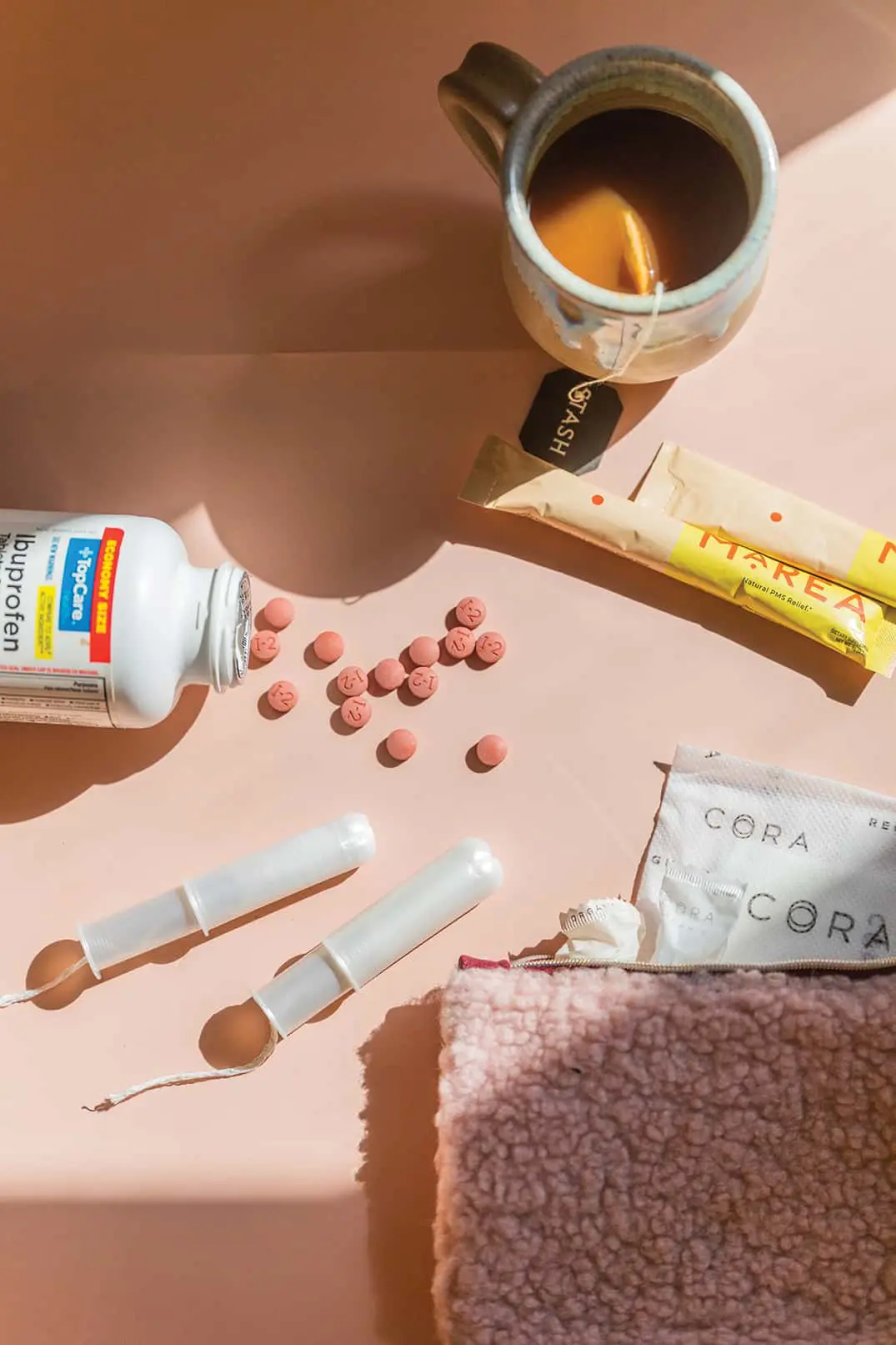Written and Photographed by Shannon Corsi
—
Growing up, I frequently had to stay home sick with period pain. I experienced pain shooting up my back, depression, cramps so bad I felt like my abdomen was going to turn inside out, and being unable to eat. I wondered, “Am I going to feel like this forever?” I googled “How long do women have periods for?” and was horrified with the results. I was in for this for the next 40-odd years of my life.
“It’s just part of being a woman,” I would hear. Truly, unfair.
As it turns out, period pain isn’t just “part of being a woman,” nor is it as normal as we’ve been led to believe. This sentiment echoed throughout my interviews with healthcare professionals as they informed me that most symptoms are treatable.
“Period pain is not normal. It’s a sign that our systems are out of balance, and our body is asking for help,” says Victor-based Monica Grohne, CEO of Marea Wellness, a supplement company that focuses on alleviating period pain. “When we’re sick, we have symptoms. … It’s the same thing when we have menstrual symptoms or [other] symptoms related to our cycle. Our bodies are saying, ‘Please help me. I need something you’re not giving me.’”
In the wake of a journey to find the root of her own PMS symptoms—one that placed her on an extensive list of supplements—Grohne aimed to create an easier solution. She built an advisory board of medical professionals, and with their input, created Marea, a convenient multivitamin made for women like herself with chaotic PMS symptoms. Marea combines fifteen essential nutrients into a relief-giving, easy-to-manage multivitamin.
Dr. Giovannina Anthony, MD, has practiced in Jackson as an OB-GYN for sixteen years and explains that period discomfort can be caused by premenstrual syndrome (PMS) or another diagnosis called premenstrual dysphoric disorder (PMDD).
“Premenstrual syndrome includes various symptoms such as bloating, water retention, mood swings, irritability, and cramps. But, there is also something called premenstrual dysphoric disorder,” she says. “I try to separate out PMS from PMDD because I think they can be mutually exclusive, as PMS is not just the mood part. It can be all of the other symptoms I mention, too.”
Dr. Anthony notes that while each patient’s tolerance is different, when a woman brings up PMS (or PMDD symptoms), it’s typically enough merit to address them, especially if the symptoms are interfering with her relationships at home or with work colleagues.
“If someone has this self-perception of ‘Gosh, you know, this particular time in my cycle comes and I don’t feel good. I’m really unhappy. I lash out at people I love. I sometimes don’t even realize it’s happening,’ then that merits some sort of treatment approach, even if it is as conservative and simple as increasing exercise or creating a stress management program,” says Dr. Anthony.
When looking for the basis of hormonal imbalances, it is rarely a single issue. Imbalances can be caused by a laundry list of things, from genetics to air quality to stress. And, some of the straightforward evidence-based, at-home treatments for these symptoms are regular exercise and a solid stress management program.
Still, Dr. Anthony explains that if patients are regularly exercising and doing everything they can, but it’s still not helping their symptoms, she can put them on hormonal contraception that suppresses their cycle completely and see if that alleviates things. “If you can suppress a [woman’s] cycle, you may see that she might not have a cycle-related disorder, after all, ” she says.
A second conventional option that works well for patients with PMS and PMDD is prescribing a selective serotonin re-uptake inhibitor (SSRI). Dr. Anthony notes the stigma surrounding SSRI’s, but mentions that there’s an option to only take them cyclically.
Our endocrine systems are complicated and change throughout life’s phases, notes Dr. McKenzie Steiner, NMD, a naturopath based in Teton Valley, Idaho. “From the teenage years to menopause, we see changes in hormones and lifestyle. It can be difficult to pinpoint what is causing hormonal disruption, and often it takes an individualized holistic approach to find what works.”
Dr. Steiner mentions that hormones change over a person’s lifetime. Patients in perimenopause often experience different symptoms than those who just started menstruating. Genetics can play a significant role as well. Women with thyroid issues or autoimmune issues, or those who have endometriosis can experience heightened PMS symptoms.
“I use questionnaires to ask people about their daily lifestyles,” says Dr. Steiner, pointing out that it helps her narrow down the culprit. “If they have some sort of natural hormonal imbalance, we look at that genetic component. It’s a process of separating things out from their environment. … Are things happening to them from an outside source or happening internally?”

Victor-based Monica Grohne created a supplement company after experiencing PMS. 
Regular exercise, stress management, and nutritional supplements can all help alleviate menstrual symptoms.
Both Grohne and Dr. Steiner reference a similar core list of components that dictate an individual’s hormone health. These include genetics, endocrine disruptors, air quality, stress, nutrition, and lifestyle.
“Our hormones are regulated within our endocrine system. We have to build and maintain a healthy endocrine system for our hormones to remain balanced,” explains Grohne. “Things like endocrine disruptors can affect that.”
Endocrine disruptors refer to things in our environment which we are all exposed to, but some people have more sensitivity to them. Plastics, air toxins, pesticides on food, preservatives found in personal care items, or chemicals in our cleaning products can all have an effect on our endocrine health.
Nutrition is another essential lifestyle component that can help balance your cycle. Grohne notes that inflammation can be caused by food sensitivities, and that same inflammation can also exasperate PMS symptoms. Eating a balanced diet—and one that is specifically tolerated by your system—can help curb inflammation. Dr. Steiner explains that red meat, dairy, fatty acids, refined carbohydrates, and alcohol can all throw your hormones out of whack. For some, taking supplements may help provide our body with the essential micronutrients it needs.
Your body can also give you clues to what’s going on, if you tune in and notice. “If your cycles are super long and your period is super light, that’s indicative of an imbalance with your progesterone to estrogen,” says Dr. Steiner. “It’s a ratio between the two—estrogen and progesterone—that may be affecting things.”
Both Grohne and Dr. Steiner stress that you don’t have to “just deal” with any kind of imbalance. Small lifestyle steps, as well as consulting a physician, can lead to a significant reduction of PMS symptoms.
At the end of the day, PMS symptoms aren’t simply part of being a woman. PMS is a nuanced set of symptoms that can point to different root causes in each woman. With a wide variety of effective resources out there for helping manage these symptoms, there’s no reason to accept the chaos as simply part of life.
